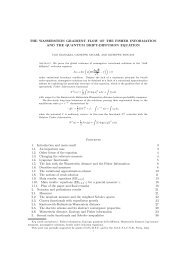Partial regularity of Brenier solutions of the Monge-Ampère equation
Partial regularity of Brenier solutions of the Monge-Ampère equation
Partial regularity of Brenier solutions of the Monge-Ampère equation
Create successful ePaper yourself
Turn your PDF publications into a flip-book with our unique Google optimized e-Paper software.
PARTIAL REGULARITY OF BRENIER SOLUTIONS OF THE MONGE-AMPÈRE EQUATION 5<br />
• Differentiability and C 1,α -<strong>regularity</strong>. As shown in [3, Corollary 1], (3.1) and (3.2) allow also<br />
to show <strong>the</strong> differentiability <strong>of</strong> ϕ at any point <strong>of</strong> strict convexity. This implies that ϕ is strictly<br />
convex and C 1 inside Ω. Finally, using again <strong>the</strong> Alexandrov estimates, <strong>the</strong> C 1,α -<strong>regularity</strong> <strong>of</strong><br />
ϕ follows by a compactness argument [5, Lemma 2 and Theorem 2].<br />
3.2. <strong>Partial</strong> <strong>regularity</strong> <strong>of</strong> <strong>Brenier</strong> <strong>solutions</strong>. In this subsection we show <strong>the</strong> partial <strong>regularity</strong><br />
result for <strong>Brenier</strong> <strong>solutions</strong> described in <strong>the</strong> introduction. As we already observed at <strong>the</strong><br />
beginning <strong>of</strong> this section, if ϕ is a <strong>Brenier</strong> <strong>solutions</strong> <strong>of</strong> (1.1) <strong>the</strong>n |∂ − ϕ| ≥ λ 2 χΩ. In particular<br />
(3.1) still holds true. The problem in this case is that we cannot deduce (3.2), since now no<br />
upper bound on |∂ − ϕ| is available [6].<br />
To bypass this problem, we will use <strong>the</strong> following two preliminary results:<br />
Lemma 3.1. Let C ⊂ BR be a convex set such that 0 ∈ C, and fix δ ∈ (0, R). Then<br />
|C ∩ Bδ| ≥ C(δ, R) |C|.<br />
Pro<strong>of</strong>. Since |C| = |C ∩ Bδ| + |C \ Bδ|, it suffices to bound |C \ Bδ|.<br />
Set D := C ∩ ∂Bδ, E := R + D = {tx : t > 0, x ∈ D}, Eδ := E ∩ Bδ, and ER := E ∩ BR. Since<br />
0 ∈ C, by <strong>the</strong> convexity <strong>of</strong> C it is easily seen that <strong>the</strong> following inclusions hold:<br />
Hence<br />
C \ Bδ ⊂ ER, Eδ ⊂ C ∩ Bδ.<br />
|C \ Bδ| ≤ |ER| ≤ C(δ, R) |Eδ| ≤ C(δ, R) |C ∩ Bδ|,<br />
as desired. <br />
Lemma 3.2. Let ϕ be a <strong>Brenier</strong> solution <strong>of</strong> (1.1), and let Z be a section <strong>of</strong> ϕ. Then<br />
|∂ − ϕ(Z) ∩ Λ| ≤ 1<br />
|Z ∩ Ω|.<br />
λ2 Pro<strong>of</strong>. Let ϕ ∗ denote <strong>the</strong> Legendre transform <strong>of</strong> ϕ. Since ∇ϕ#χΩ ≥ λ 2 χΛ, for a.e. y ∈ Λ <strong>the</strong>re<br />
exists x ∈ Ω such that x ∈ ∂ − ϕ ∗ (y). Thanks to (2.1), this implies that ∂ − ϕ ∗ (y) ∩ Ω = ∅ for all<br />
y ∈ Λ, so by <strong>the</strong> boundedness <strong>of</strong> Ω we deduce that ϕ ∗ is Lipschitz, and hence differentiable a.e.,<br />
inside Λ. This gives<br />
|∂ − ϕ(Z) ∩ Λ| = |∂ − ϕ(Z) ∩ Λ ∩ (dom∇ϕ ∗ )|.<br />
Now, thanks to <strong>the</strong> duality relation (2.2), if y ∈ ∂ − ϕ(x1) ∩ ∂ − ϕ(x2) and y ∈ dom∇ϕ ∗ <strong>the</strong>n<br />
x1 = x2. This implies<br />
(∇ϕ) −1( ∂ − ϕ(Z) ∩ (dom∇ϕ ∗ ) ) ⊂ Z.<br />
Combining all toge<strong>the</strong>r and using <strong>the</strong> definition <strong>of</strong> <strong>Brenier</strong> solution we finally obtain<br />
|∂ − ϕ(Z) ∩ Λ| = |∂ − ϕ(Z) ∩ Λ ∩ (dom∇ϕ ∗ )|<br />
≤ 1<br />
λ 2<br />
<br />
−1<br />
(∇ϕ) ( ∂ − ϕ(Z) ∩ (dom∇ϕ ∗ ) ) ∩ Ω <br />
1<br />
≤ |Z ∩ Ω|.<br />
λ2 Thanks to <strong>the</strong> two results above, we can show <strong>the</strong> following key estimate, which will play <strong>the</strong><br />
role <strong>of</strong> (3.2) in our situation:



